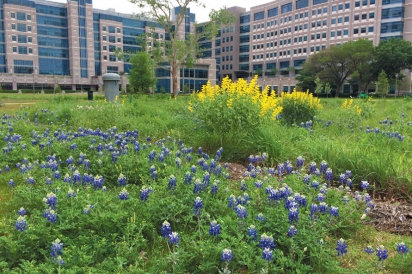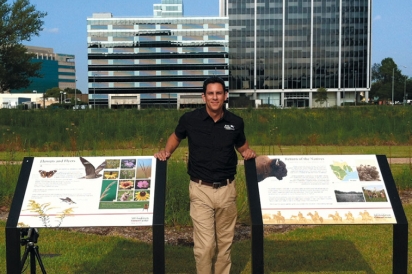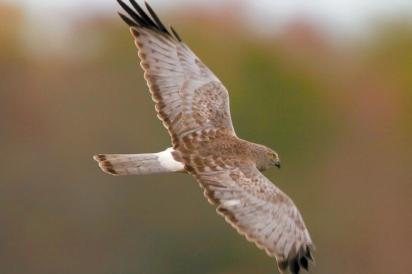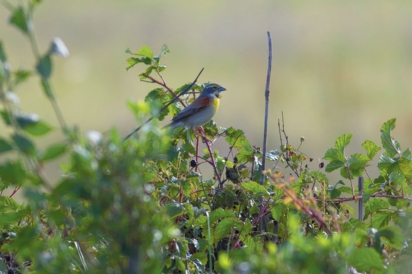Birth of a Prairie at MD Anderson
When MD Anderson Cancer Center demolished an iconic medical center building in 2012, they could have built a parking lot. Instead, they built a prairie. At the time, it was a temporary solution until another building was built. A prairie would be less expensive than a parking lot, and, over time, it would save on the cost of traditional lawn maintenance. What MD Anderson didn’t realize then was that they were about to create a healing station in the middle of the nation’s largest medical center, and that prairie fever would spread to the rest of their 220-acre campus.
MD Anderson’s choice to build a prairie was not for cost, alone. It fit with the health values of the cancer institute, and it fit with the 1100 Holcombe site. This corner of one of the busiest streets in Houston had once been an ancient prairie, like most of the area before the 1930s. The Texas Medical Center, Rice University, Hermann Park and the Dome complex had been wide, open prairie. No trees. Just prairie.
Since most of us are not schooled on the merits of a wide, open space, such a place can, at first, appear dispensable and lifeless, a perfect canvas for filling with modern architecture and complex campuses. In reality, these places can be teeming with life.
Jaime González knew this well. At the time, he was developing community education with the Katy Prairie Conservancy. He saw various groups operating independently — not joining forces or really sharing information. The priority of the prairie was already under way in various camps, so González decided to bring them together. With no particular agenda except to ask some big questions, he gathered the prairie community on April 17, 2009. The like-minded folks included Flo Hannah, Houston Audubon, Texas Master Naturalists, Hermann Park Conservancy and the Houston Zoo. Two outcomes of the meeting that day were the formation of the Coastal Prairie Partnership and the commitment to create a prairie in a highly visible area.
Prairie near the park train
The site the group decided on was in Hermann Park near the tracks of the park’s railroad, on the edge of McGovern Pond. Not only was this site once a prairie, the site was visible to a variety of ages and nationalities that visit the park every day.
But would a prairie take hold in a small patch? On April 17, 2010, the group put 2,000 plants in the site, complemented by seed hay from Nash Prairie, an ancient prairie near the Brazos River. With all that potential packed into a 60-foot by 40-foot site, the prairie could not fail. In fact, it thrived from the start. Since then, it’s only needed occasional thinning and annual cutting.
“It’s a tiny space,” says González, “but I can tell you after watching it evolve over the last eight years that it is the most biodiverse, action-filled area in the park, even with its smallness.
After establishing the Whistlestop Prairie, the group didn’t have a grand plan. But a second opportunity soon presented itself. By then, MD Anderson had already decided to demolish the old Prudential Life building on Holcombe. Kenneth Franzheim’s 18-story statement of late modernistic elegance had outlived its usefulness for the medical center complex. One of MD Anderson’s architects, Dan Butterwick, was familiar with González’s conservation work, and knew the Holcombe property would be idle for a number of years. After Butterwick arranged introductions, a discussion began in early 2012 about creating a site that would benefit the community.
Building in an urban dead zone
To nearly everyone, a prairie made sense, more sense than a manicured lawn. But it would have to start from scratch. During the site assessment, González discovered that this future prairie site was an urban dead zone, a lifeless property. In the entire parcel, “I found one wolf spider,” he says.
“That was it. There was a parking lot and very little vegetation around the building. From a biological standpoint, it was dead. And it was hot. It was serving a function, but it was not amenable for life.”
Add to this, a few things got off to the wrong start: The initial seed mix planned with landscape architecture firm Asakura Robinson was planted in August 2012, and did not yield the best results. The fill dirt was “the worst soil in history,” and the area required irrigation. González then called on the Wildlife Habitat Federation for help. They provided the right seed blend, equipment and installation technique for the prairie to establish and grow. The big four native grasses were brought in: little bluestem, big bluestem, switchgrass and indiangrass. To kick-start microbes in the soil, Sustainable Growth Texas provided several rounds of a compost tea created from native prairie soil. Then, a good rainfall pattern occurred a few months later in 2013.
With all these elements coming together, González says, “the prairie started blossoming. By the fall, it structurally looked really, really nice. That’s probably the quickest pop-up prairie of that size that I’ve done. And it looked great.”
During the MD Anderson project, down the street another prairie effort was getting under way: Rice University was working to restore its three-acre Harris Gully Natural Area. The stream on the campus’ south side, at one time the only wooded area for miles around, is still a functioning drainage basin. With the woods long gone, the area has become an open space perfect for seeding a prairie. Rice needed assistance that initially came from working with the Nature Conservancy to plant indiangrass, gamagrass, switchgrass and little bluestem. Still in need of help, Rice recently secured funding for students to re-plant the prairie while conducting comparative biodiversity studies of the Whistlestop Prairie, the M.D. Anderson Prairie and its own prairie.
Build it and they will come
In addition to plants, González has noticed that these urban prairies have a concentrating effect for wildlife. Packed into MD Anderson Prairie’s 1.7 acres are eastern cottontail rabbits, green anole lizards, turtles, birds of all sizes, countless species of insects and several varieties of bees and butterflies. “We get a bunch of monarchs in the Fall. It’s wonderful,” says González. “Because people have monarch-attracting milkweed in their backyards, they don’t realize that they are actually a prairie butterfly. But they are. There used to be monarchs all over the prairie.” González has also seen unusually high numbers of migratory birds stopping by the M.D. Anderson Prairie. “Warblers and such will stop there, feed on insects and then continue south. I saw a hooded warbler there last year, working the prairie, looking for insects as it was headed south. American woodcock have been spotted over there. And, the nighthawks— which are fabulous to have in the city—sometimes there will be three or four above the prairie on a summer evening getting insects. It just goes to show you that if you situate the right vegetative community and the right habitat, it really does not take long for wildlife to find it and to use it.”
The Human Soul-Charging Station
After working with prairies for over a dozen years, in the summer of 2014 González personally experienced how viscerally a prairie can nurture us.
Three weeks near the end of her pregnancy, his wife, Katy, and their son she was carrying nearly lost their lives one night in a deadly combination of placental abruption and preeclampsia. During the week of recovery following Katy’s emergency C-section, González would occasionally take a break and go across the street from Texas Children’s Hospital to the MD Anderson Prairie.
On those long summer evenings, González found himself doing “exactly the same thing that the doctors and nurses and family members do that sit out there and watch the flowers sway back and forth.” The prairie was a mental health station, a soul-recharging station. “It reminded me of not only the sanctity of life, but also the cycle of life.”
In his role now with the Nature Conservancy, González is creating urban prairies in other parts of the city. He’s doing it, in part, for humanity’s sake.
“We have this primal need to connect with nature. When we deprive ourselves of that, we become more stressful. We are not as healthy. Our blood pressure goes up. So, when we see highly urbanized areas like this medical center, we have got to soften it up with some nature. We’ve got to, just for humanity’s sake,” because “nature is the oldest relationship we have.”









